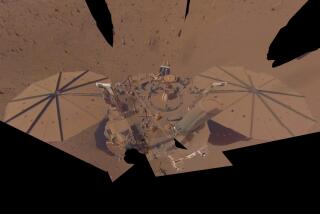Rivers, lakes and deltas, oh my! Mars rover probes crater’s watery past
- Share via
Was Mars once a land of lakes, protected by a thick atmosphere? That’s been up for debate as scientists try to determine how wet the now-parched planet once was -- and how long it stayed that way. But NASA’s Curiosity rover has uncovered evidence that Gale Crater was once filled with a lake whose water level could have risen and fallen over tens of millions of years.
The rover’s findings from the base of Mt. Sharp raise the likelihood that Mars was habitable long enough for microbial life to potentially emerge.
Mars may be pretty dry now, but that wasn’t always the case, scientists say. And while much of the water the planet once had was locked up in ice or stored underground, some of it must have made its way to the surface, said Curiosity deputy project scientist Ashwin Vasavada of NASA’s Jet Propulsion Laboratory in La Cañada Flintridge.
“Mars was once a planet shaped by water,” Vasavada said in a news briefing Monday. “Landscapes from that time are like relics today -- they’re out of place, unexplained by the current climate.”
Curiosity found signs of past water, as well as key chemical ingredients for microbial life, in a spot called Yellowknife Bay in 2013. But exactly how long did this habitable environment last? These conditions would have to persist for a long time -- millions of years, if not more -- to give rudimentary life a chance to emerge.
But around the base of Mt. Sharp, Curiosity has found slanted rock formations that, on Earth, are signs of a delta -- a zone where running water from a river meets the standing water in a lake. While this lake was probably only a few meters deep, it probably filled and drained multiple times over tens of millions of years, scientists at JPL said.
Mt. Sharp, which sits in the center of Gale Crater, probably did not exist when the crater was still a lake. The rocks Curiosity studied indicate that water was flowing toward the center, which would have been difficult to explain if Mt. Sharp was there.
Over time, as the lake rose and fell, the mountain was probably built up by tiny bits of sediment carried by water and wind, and then carved into a peak by winds blowing from the crater rim to the edge of the mountain, JPL researchers said.
All the water would indicate that Mars’ atmosphere was much thicker, warmer and wetter than it is today, with a vigorous water cycle that would have fed these lakes, Vasavada said.
How thick and protective the Martian atmosphere really was could be answered by NASA’s Mars Atmosphere and Volatile EvolutioN mission, which is orbiting Mars to study what remains of its thin upper atmosphere.
Curious about Curiosity’s next move? Follow @aminawrite for more science news.







